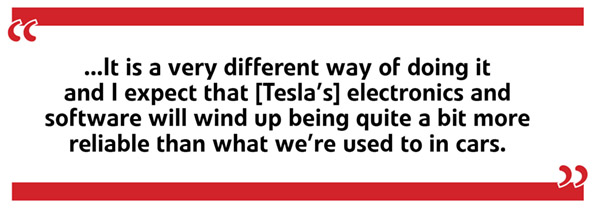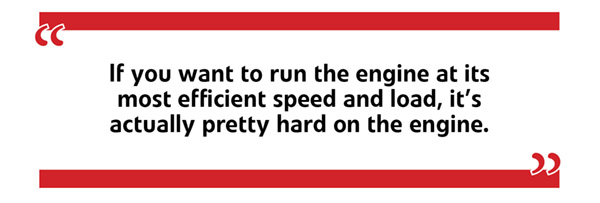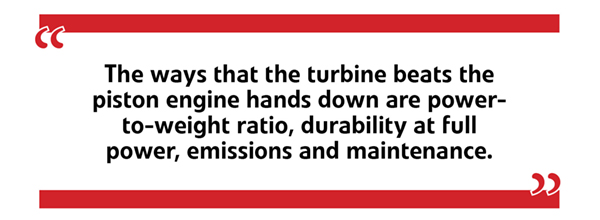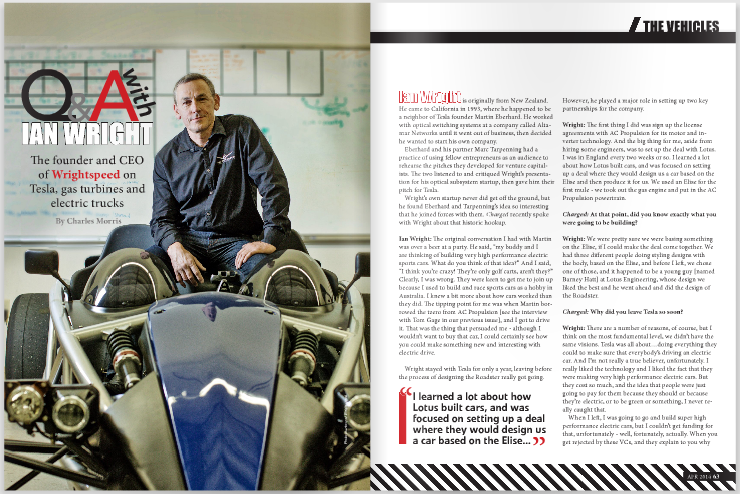Ian Wright is originally from New Zealand. He came to California in 1993, where he happened to be a neighbor of Tesla founder Martin Eberhard. He worked with optical switching systems at a company called Altamar Networks until it went out of business, then decided he wanted to start his own company.
Eberhard and his partner Marc Tarpenning had a practice of using fellow entrepreneurs as an audience to rehearse the pitches they developed for venture capitalists. The two listened to and critiqued Wright’s presentation for his optical subsystem startup, then gave him their pitch for Tesla.
Wright’s own startup never did get off the ground, but he found Eberhard and Tarpenning’s idea so interesting that he joined forces with them. Charged recently spoke with Wright about that historic hookup.


Ian Wright: The original conversation I had with Martin was over a beer at a party. He said, “my buddy and I are thinking of building very high performance electric sports cars. What do you think of that idea?” And I said, “I think you’re crazy! They’re only golf carts, aren’t they?” Clearly, I was wrong. They were keen to get me to join up because I used to build and race sports cars as a hobby in Australia. I knew a bit more about how cars worked than they did. The tipping point for me was when Martin borrowed the tzero from AC Propulsion [see the interview with Tom Gage in our previous issue], and I got to drive it. That was the thing that persuaded me – although I wouldn’t want to buy that car, I could certainly see how you could make something new and interesting with electric drive.
Wright stayed with Tesla for only a year, leaving before the process of designing the Roadster really got going. However, he played a major role in setting up two key partnerships for the company.


Wright: The first thing I did was sign up the license agreements with AC Propulsion for its motor and inverter technology. And the big thing for me, aside from hiring some engineers, was to set up the deal with Lotus. I was in England every two weeks or so. I learned a lot about how Lotus built cars, and was focused on setting up a deal where they would design us a car based on the Elise and then produce it for us. We used an Elise for the first mule – we took out the gas engine and put in the AC Propulsion powertrain.
Charged: At that point, did you know exactly what you were going to be building?
Wright: We were pretty sure we were basing something on the Elise, if I could make the deal come together. We had three different people doing styling designs with the body, based on the Elise, and before I left, we chose one of those, and it happened to be a young guy [named Barney Hatt] at Lotus Engineering, whose design we liked the best and he went ahead and did the design of the Roadster.
Charged: Why did you leave Tesla so soon?
Wright: There are a number of reasons, of course, but I think on the most fundamental level, we didn’t have the same visions. Tesla was all about…doing everything they could to make sure that everybody’s driving an electric car. And I’m not really a true believer, unfortunately. I really liked the technology and I liked the fact that they were making very high performance electric cars. But they cost so much, and the idea that people were just going to pay for them because they should or because they’re electric, or to be green or something, I never really caught that.
When I left, I was going to go and build super high performance electric cars, but I couldn’t get funding for that, unfortunately – well, fortunately, actually. When you get rejected by these VCs, and they explain to you why they don’t think your business model is any good, I think you can learn something from it. Eventually, I figured out probably the best application for the technology was in vehicles that use an awful lot more fuel than family cars do, so that would be trucks.
I’ve learned a lot from watching Tesla’s trials and tribulations from afar, and it was pretty clear that trying to build cars and car factories wasn’t as easy as we thought it was going to be. If you concentrate your effort on the powertrain only, then you can figure out a way to get the powertrain to market without having to build car factories and build cars. So, that convinced me to just do the powertrains, and do them for medium-duty trucks as repower kits. That’s a pretty different vision than Tesla’s.
Charged: Any entertaining anecdotes from that time?
Wright: I learned a hell of a lot in the time I spent at Lotus Engineering in the UK. Lotus Engineering is one of the premiere auto engineering companies in the world when it comes to suspension design, tuning, ride and handling development. I remember being very humbled one day when they offered us a chance to drive on their test track with one of their development drivers. Those guys are unbelievably good.
Charged: So, that was an integral part of the Roadster’s ride and suspension. A lot of that stuff came from Lotus?
Wright: Yes, and they really are probably one of the best in the world for doing that sort of thing. You’d be surprised if you knew how many famous high performance cars they have given their treatment to – it’s just not advertised.
Charged: What would you say Tesla’s long-term impact will be?
Wright: It’s clear that they’ve made an enormous difference to public perception at a very wide range of levels. Part of what we set out to do in the beginning was to change the public perception of electric cars, because the public really did think like I did: They’re golf carts, aren’t they? That isn’t the public perception now at all. So, I think Tesla’s already changed the world in pretty important ways about the perception of EVs. Obviously, they’re trying to drive the costs further and further down and it’s tough, and I certainly wish them all the luck in the world with that. You have to say, to a large extent, that the Nissan LEAF and the Chevy Volt and the Ford EVs are all a reaction to what Tesla did, because if you go all the way back to 2003 when we started this thing, the California zero-emission mandates had just been repealed, all the EVs that were on the market then were taken off the market, the EV1s were taken back and crushed, and no major auto manufacturer was even talking about doing EVs. They were all running as far away from it as they could.
Charged: What about the way cars are developed or manufactured? Do you think Tesla has had an impact on that?
Wright: Yes. Perhaps not in the way that people might immediately think. The way that Toyota manufactures a car, the way they stamp the metal and weld them together and paint them and do all the interior bits and put the car together, it’s kind of hard to beat that. I’m not sure that Tesla’s made any advances on that, or even gotten to the level of doing that. On the other hand, if you’re a Silicon Valley technology engineer, and you look at the way modern cars are designed from an electronics and software point of view, to use an Australian expression, it looks like a dog’s breakfast. It doesn’t appear that they have what we would call a systems architecture. What they do is they go to their Tier 1 suppliers – they might go to Bosch and say, I need an electronic control unit for the ABS system, and then they go to somebody else and say, I want an entertainment system, I want a radio and DVD player and so on. I’m looking out the window at my 2008 Volkswagen Touareg, and I bet that’s got sixty or seventy electronic black boxes, probably three hundred pounds of wiring harness, and software from twenty different companies in it. The major reliability problem with those sorts of cars is the electronics and software. I think Tesla did take a real Silicon Valley systems architecture perspective in designing all the electronics. I don’t know to what extent that way of doing things will translate to the big guys, but I think it is a very different way of doing it, and I expect that their electronics and software will wind up being quite a bit more reliable than what we’re used to in cars.


If you look at the user interface in my VW, it’s got a color LCD right there in the middle of the instrument cluster and it drives me crazy. There’s plenty of room to have lots of information on there, but they’ve divided it into a bunch of big fields. One of the fields gives you the outside air temperature. That’s good – I can always tell what the air temperature is outside until the low fuel warning goes off. When your low-fuel warning goes off, they overwrite the temperature with the low fuel warning icon and until you put more fuel in the car, you can no longer tell what the outside air temperature is. They could so easily have moved stuff around and put that somewhere else. They couldn’t do that because the way they developed things, there was a specific crew that did that, a specific piece of code, it’s done this way. So, that’s the sort of thing that Tesla gets right in their sleep, and the big guys really struggle with.
Charged: Now that the majors are developing EVs, will that force them to make the electronics better?
Wright: I think it can’t hurt. I think they’ll still have the problem that they generally don’t develop any of that stuff themselves. They write a spec and they send it out to Tier 1 suppliers. If they’re still doing it that way, I think they’re still going to have a problem.
Charged: Tell us about what you’re doing with your company, Wrightspeed.
Wright: Our initial market is medium-duty trucks, so think of the package-delivery guys: FedEx, UPS, DHL. They can drive those trucks for a lot of years, and the engines and transmissions die, and they change over two or three times during the life of the truck. You can take out the diesel engine, the transmission, the rear axle, fuel system, instrument cluster, and replace the whole thing with our powertrain. When you’re done, then you’ve got basically an electric truck with a range extender generator, and in our case it’s a gas turbine, and the turbine will happily burn natural gas, or diesel or biodiesel. Suddenly, instead of getting eight or ten miles to the gallon, you’re getting 25 or 30, depending on your drive cycle.


Of the 2.2 million medium-duty trucks in the US [Class 3 to 6, 11,000 to 26,000 pounds], about 10 percent of those get a new powertrain every year. That’s 250,000 new engines and transmissions per year. That varies a lot – in the parts of the country where they salt the roads heavily in the winter, they don’t get twenty years out of the chassis, so you might actually not replace the engine in one of those trucks. In California, that chassis might be good for thirty years and they go through three engines, or even more. The interesting thing is that we can sell directly to the fleet operator, the guys who own the trucks. We don’t have to go through the cycle of doing a deal with the truck manufacturer, getting the powertrain approved and all of that.
Of course, we can also go into new vehicles. The truck industry is very different from cars. The package-delivery guys, the way they buy those trucks is they go to, say, Freightliner, and they say, I want the MT45 chassis, and I want the Cummins engine, and I want an Allison transmission, and a Meritor axle, and I want you to ship all of that down to Michigan, to Spartan Motors, the UtiliMaster Group, and have them build a custom body on it. The fleet owner can just as easily say to Freightliner, well, I want the MT45 chassis, I want the UtiliMaster body, but I want the Wrightspeed powertrain. We’re about the only range-extended powertrain, with the only retrofit kit.
We’ve now got a customer signed up to use a version of our powertrain in garbage trucks. The nice thing about garbage trucks is that they’ve got far and away the best drive cycle for us. We can save the most fuel. The average full-size garbage truck is doing about a thousand stops a day, and they’re hard stops – they’re triggering the ABS on most of the stops. They’re doing about 130 miles a day. They’re doing 2.8 miles per gallon. Putting our powertrain in there, we can save them about $35,000 a year in fuel per chassis, and another $8,000 in maintenance for the truck.


Charged: Your powertrain includes a micro-turbine generator. Tell me more about that.
Wright: It’s an engine that burns fuel and drives an electric generator that charges the battery. The interesting thing about a generator duty cycle for an engine is that it’s pretty hard work. If you want to run the engine at its most efficient speed and load, it’s actually pretty hard on the engine. If you were to take a little 4-cylinder car engine, they usually run about 5,000 hours for a car, so most of the time they’re not working very hard. If you take one of those engines and put it on a generator at wide open throttle and full power, you’ll be lucky to get five hundred hours out of it. If you look at stationary generators, conventional piston ones, a 30 kW stationary diesel generator will have a 4-cylinder Cummins engine, it will run 1,800 rpm, it’ll weigh 2,000 pounds and it’ll run for 10,000 hours at full power. That’s way too big and heavy to put in a vehicle.
However, if you use a gas turbine for the engine, then suddenly it all changes. They run very much faster – the one we use runs at 96,000 rpm. The 30 kW generator assembly is about as big as a one-liter bottle of Coke. And the engine itself isn’t much bigger. That engine doesn’t have a lubrication system, it runs on air bearings and there’s only one moving part. So, that engine will run 40,000 hours at full power. That’s a big deal. The thing weighs 220 pounds in total, so it’s about ten percent of the weight of a stationary engine and it’s got at least four times the life of the heavy ones and forty times the life of the light ones.
The next big deal about the turbine is that they are amazingly clean engines. The one we’re using now beats the current California emission standards by a factor of ten… without any after-treatment. Not even a muffler. Meeting the emission standards in California with a diesel truck engine is becoming harder and harder, and more and more expensive. Some of our customers are no longer using diesel truck engines in California in their medium-duty trucks. They’re going back to gasoline V8s. They’re burning 40 percent more fuel and they only last half as long as a diesel engine, but it’s still better than trying to meet CARB standards. They could tighten the standards quite a lot from where we are and we would have no trouble meeting them.
The worst thing about turbines is that they’re only efficient at full power. At idle power, the fuel flow is like 30 to 50 percent of the fuel flow at full power. With a normal diesel engine, when you idle, it’s maybe burning two to five percent of what it would be at full power. That’s the big difference with turbines. You can’t just put one in a car because, in a car’s duty cycle, most of the time you’re using very little power. An average family car has 250 horsepower [but most of the time] they’re probably only using about 25 to 50 horsepower.
Charged: So, the turbine engine only makes sense in a truck if you have an electrified powertrain?
Wright: Correct. If you use it in a series hybrid or a range-extended EV like we do…it’s running at a constant speed and load. When it’s finished charging the battery, it shuts off. So you get all your power from the battery, and that whole process is really efficient in electric drivetrains. We can completely decouple the engine load from the road load and the electric battery takes care of the road load, the engine is driving the generator and charging the battery and we just keep it at the sweet spot.
Charged: Your turbine can burn different types of fuel?
Wright: Yes, actually the same turbine. When you buy one, you choose whether you want it with liquid fuel [diesel or biodiesel] or you want it with gaseous fuel. If you order it for gaseous fuels, then you can burn natural gas, compressed natural gas, liquefied natural gas, propane or landfill gas. The combustion process in the turbine is very different from in a piston engine.


Don’t make the mistake of thinking they’re more efficient, they’re actually not. Absolute efficiency is not one of the strong points of turbines. It’s fairly hard to get them to be as efficient as a piston engine. The ways that the turbine beats the piston engine hands down are power-to-weight ratio, durability at full power, emissions and maintenance. There’s no lubrication system, there are no cooling system, no belts, no hoses and no maintenance on the engine except the air filter. Where we gain efficiency is the fact that it’s a series hybrid, and therefore we can run the engine only at its most efficient point.
Charged: So, it’s the hybrid system that gives you your efficiency gains, not the actual turbine? Is that what offers fleet operators the huge fuel savings?
Wright: Yes. The medium-duty truck fleet in the US is spending $35 billion a year on fuel. If you look at a company like UPS…their total fuel bill was $4 billion. Some of that is air traffic and some is long haul, but some of it is medium-duty trucks. The price of fuel went up by a dollar a gallon, and their bottom line went down by a billion dollars. So, if we could save a reasonable percentage of that fuel, it would be worth some pretty serious capital investment on their part.
The big fleets have tried all the stuff. They’ve tried the hybrids and the electric trucks and they’ve been pretty unhappy with all of it so far. They’re a little bit cynical. They want to make sure it works. You also have to be careful about picking the right drive cycle. You’ve got to be able to save enough fuel and maintenance per year to make the capital investment worthwhile for the customer. For example, the package-delivery guys delivering in Manhattan – that truck will only do six miles a day because the poor sucker that drives it finds a parking spot somewhere, then he gets out and hand-delivers packages and spends the next two hours running. Also, the long-haul guys – we can’t help them very much either, because their big rigs are out on the interstate at 62 miles an hour, straight road. We don’t get the regen braking gain because they’re not starting and stopping, we don’t get the plug-in gain because they can’t carry enough batteries. They’re going 400 or 500 miles a day and we can do maybe only 40 on the battery. Now, big rigs that are used for delivering to your local Safeway, they’re a good target. Garbage trucks are the best drive cycle. If you pick the right drive cycle, then it’s a compelling economic case.
Charged: Looking at the future of EVs, is there some story that’s not being told? Something people are missing?
Wright: You can go a long way further with the control aspect of high performance electric cars. There have been a few prototypes built now – Mercedes has built one and there are a couple of others, where they run high power motors, one per wheel. We’ve just got a patent approved for how we do that, and it’s quite different from how the other guys are doing it. One of the problems with conventional high performance cars is that people buy them and they think they’re racing drivers, but they’re not, and they get themselves into trouble. I think with the way we do the slip control of the tires…you can make cars very much safer for the average driver. I think that people haven’t really figured out yet that the control aspect is so much better than what you can get with a traditional powertrain. Once you start seeing cars on the road that have that, everyone’s going to want it.
Charged: It sounds like you firmly believe the plug-in, or range-extended vehicle, is the way to go.
Wright: It depends what problem you’re trying to solve and what the use for the vehicle is. If you want to make electric vehicles today, with today’s fuel and battery prices, to make economic sense, then range-extended is the way to go.
Charged: Do you think that’s going to change in the future? How long do you think before the batteries get cheaper and the pure EV comes into its own?
Wright: Two big factors are battery cost and fuel price. There’s actually a tipping point – if batteries get below a certain price and fuel goes up in price, then suddenly the pure EV is more compelling than the range-extended EV, because it’s now cheaper to have more batteries than to have a generator for certain applications. But I have no faith in the idea that we’re going to put in a new infrastructure for fast charging or battery swapping – we can’t even afford to fix the potholes in the road! But the fueling system’s already out there for diesel and gasoline, so I think range-extended is going to be the thing for a very, very long time if you need the range. People talk about decreases in battery cost, but it’s not happening, and I think it’s unlikely to happen for a bunch of good reasons. Fuel prices, on the other hand, are pretty volatile and continually go up. I think in order to get to that tipping point, we’d have to see fuel prices up to about $11 a gallon, then suddenly, EVs make more sense than range-extended EVs for a bunch of applications. But for $3 or $4 a gallon, range-extended is the way to go.
This article originally appeared in Charged Issue 13 – APR 2014

















































